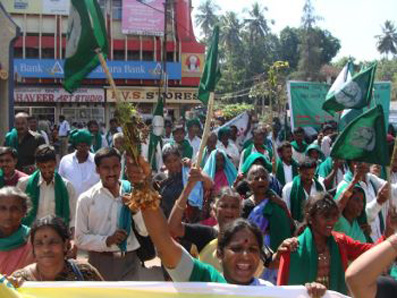 |
Peoples' movements and protests |
 |
|
MobilizationsThe Grundtvigian peasant movementIrish Land LeagueBavarian Farmers’ UnionFarmer’s AllianceThe Zapatists of MorelosKisan SabhaThe Chinese peasant movementThe Vietnamese peasant movementLa ConvenciónKRRS and Shetkari SanghatanaFrench peasant resistanceThe Zapatists of Chiapas Via Campesina
|
KRRS and Shetkari Sanghatana
India’s farmers won their land when the country became independent. They had been such an important part of the independence movement that their interests could not be ignored. But they won it on the same terms as other farmers in the world – they got the land but they were forced to buy from the state and sell to the state and accept the state’s prices. It was the peasants who had to pay for the industrial development of the independent states. Even in India. In the beginning, everything was still peace and joy. The farmers participated in the ”green revolution”, i.e invested in high-yielding crops that required a lot of fertilizer, spraying and water. When food prices fell, farmers were ruined – one-third of the pioneer state of Punjab was wiped out in the 1980s. It was in Punjab that the first Indian peasant movement was formed with market demands on the program: better prices. In addition, control over the water channels that the state used to divide and rule with. The movement was at the same time a Sikh revival in the same way as the Danish peasant movement in the 19th century<LÄNK> was Christian. It gave a moral strength. But the movement also appealed to non-Sikhs – something the Indian government stopped when it blew up Sikh temples and started religious wars. Today, the peasant movements in Maharashtra and Karnataka are the strongest. They have many features in common. They largely lack officials. Karnataka's KRRS has no membership register but says after random sampling in a few hundred villages it estimates the number of members at 10 million. They consist of channels for mobilization in time-limited issues, where the peasants’ children usually serve as organizers. They organize giant meetings for education, discussion and protest – the mass meeting that burned down the grain giant Cargill’s office in 1998 consisted of 750,000 people. They run the demands of the rural population, not just the peasants – India’s strongest women’s movement is the rural women of Maharashtra organized by Shetkari Sanghatana and the mobilizations against giant dams and deforestation are driven by peasants. They push ideologically far-reaching demands for public knowledge in protest against patent rights on genes while at the same time leading a trade union struggle for pennies. They see themselves as the movement of the popular India, Bharat, towards the middle-class India. The emphasis of the two organizations differs. Shetkari Sanghatana is mainly directed against the state and its oppressive food price policy, while KRRS sees its main enemy in the technical monopoly demands of the transnational food corporations. This didn’t not prevent them from jointly taking the lead in India’s peasant movement around 1990 and writing a program which, among other things, accommodates stops for dams and demands for transnational seeds as well as higher wages for farm workers. Below: Indian farmers burn Monsanto's experimental crops.
Reading
|

